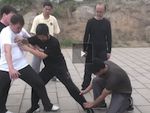While observing my training, Master Chen explained that I had slack in my foundation exercise. He went on to clarify that when I was in a posture and started the transition to another posture the tension/stretch was lost. This stretch must be maintained even if one is letting a joint adjust. Master Chen used the example of the elbow, the section below the elbow must be like a stick, and the section above the elbow must also not be slack. To elaborate, Master Chen said to think of a car. Even though the gears rotate, the physical structure of the car is solid. He said that this concept of removing the slack must be used on all parts of the body so that in push hands you will not collapse under the push of your opponent.
Next, Master Chen spoke on posture. He was pointing out the delicate balance of where the knee placement was relative to foot on the front leg. During this demonstration I made a learning error which I will share for the benefit of readers:
Master Chen was showing me specifically the placement of the front leg, pointing to the front leg to make that clear. After I was convinced that I had an image of how his leg was positioned, I moved around to get another perspective of the overall posture, this is a mistake. Master Chen pointed out that he was specifically making sure that the front leg was correct so that we could learn from the placement. He went on to say that he may even sacrifice some other aspects of his posture to make sure the single point is demonstrated as accurately as possible, so if we as observers look elsewhere we may be copying an incorrect body position.
Specific to the posture, Master Chen demonstrated when the knee was too far back how there was an inability to get full power out of the front lower leg muscles (Tibialis anterior, and Extensor digitorum longus from what I felt). When the knee was bent too far forward, Master Chen demonstrated the inability to get a bite (also resulting on the muscles not engaging). Once the position was correct, he demonstrated that a bite could be obtained, and this could be felt through the Master Chen’s leg muscles.


